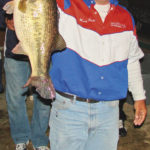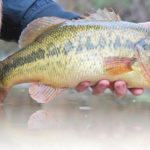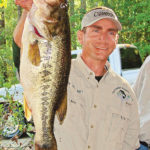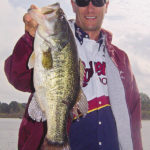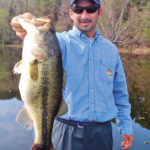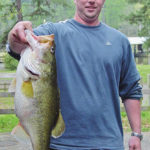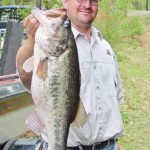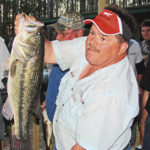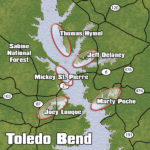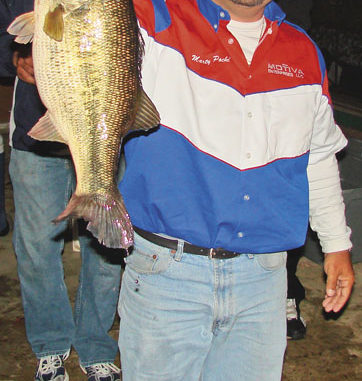
This group of South Louisiana anglers looks forward all year to their annual trip to Toledo Bend.
Some aspiring bass anglers from around Paulina graduated together in the late 1980s. They started making a yearly run to Toledo Bend, while trying to get noticed enough to be accepted into the biggest local club there was at the time, Road Runner Fishing Club.
According to Marty Poche, all these “young bucks” found a tough go of it trying to get in this elite group of experienced bass anglers. Therefore, they decided to form their own group, Tri Parish Fishing Club, in 1991.
“We got our membership up to 25 or 30 guys,” Poche recalled, “and we implemented the March tournament at Toledo Bend.
“Actually it was at the end of February when we first started going, but it was rough because fronts would come through and the fish weren’t moving up.”
In other words, if you weren’t out on the main-lake points throwing Carolina rigs, you weren’t catching any bass at that time of year. And there wasn’t much stranger than watching a bunch of guys who grew up fishing the Basin, Des Allemands, Bayou Black, Caernarvon and Venice trying to catch bass on a Carolina rig in 30 feet of water.
“The bass just weren’t there yet in the shallow water,” Poche continued. “Road Runner was already going at the end of March, and they smoked them every time, so we decided to move and get in line with them.
“It was like a switch went off with just that one little three- or four-week period. Toledo Bend was a whole different lake.”
Now, assuming no fronts roll through the area, it takes a two-day, 10-fish limit around 40 pounds to win the club tournament they hold on Thursday and Friday the week they’re in town. Club members landed one 8-pounder, two 9-pounders and one 12-pounder a few years ago, and somebody usually gets close to a 10-pounder each year.
Only one time has the club had to nix its plans to go to Toledo Bend, and it was because the water was so low there weren’t enough ramps in the water. Tri Parish wound up going to Lake Guntersville in Alabama that year.
With Toledo Bend being so low this winter, the club voted to set 163.5 as the level that would determine if they go to Toledo Bend. Anything over that mark, and Tri Parish Fishing Club will be there. Anything under, and the folks around Lake Seminole on the Florida and Georgia border will wonder what brought Mardi Gras to town.
If they’re at Toledo Bend, five of the club’s most experienced members offered up where they’ll be and what they’ll be fishing.
Marty Poche
Marty Poche, a Paulina resident and current member of the Louisiana Bass Federation State Team, typically likes to fish Negreet, the first major creek south of Pendleton Bridge on the Louisiana side of the lake. For him, Negreet offers the perfect combination of deep and shallow water.
“You got a lot of shallow-water flats with deep water nearby that feeds bass up in there pretty good,” Poche said. “It’s important to figure out what stage they’re in — if they’re still deep or if they’re posting up on the secondary points or they’re already on the flats and ready to spawn.”
To quickly figure out how far bass are along in the spawn, Poche starts out on the primary points and moves to the secondary points as he makes his way to the flats. He enters on the south end out at the mouth of Negreet where the channel runs close to some shallow pockets.
“I start out in 20 to 25 feet of water and head straight into 12 and on into 3,” Poche explained. “I like to fish some Carolina rigs out on the deep edge of the grass if they’re still out deep, but for me, the Rat-L-Trap works from all the way out deep to as shallow as the fish want to go.”
Poche typically throws either a black/gold or chrome/blue 1/2-ounce Trap on 15-pound monofilament line with Shimano reels and Falcon rods. He sometimes tries the 3/4- or 1-ounce crawfish-colored Trap out on the deep edge of the grass in about 12 feet of water, but the 1/2-ounce model gets most of the work.
In Trapping-the-grass fashion, Poche rips his lure through the grass and gives his rod a jerk when his lure loads up with grass. This erratic action snaps his lure forward, often triggering reaction strikes from nearby bass. A recent key for Poche has been to add a red belly hook to his Trap.
“I also catch some bass throwing the Spook Jr. and a Rattlin’ Rogue,” Poche said. “And sometimes I’ll throw lizards or wacky worms if the bass are on the beds.
“I haven’t caught the numbers of big bass in Negreet as I have in the past, but there are still some really big fish in there.”
Thomas Hymel
Also a founding member of Tri Parish Fishing Club, Thomas Hymel is another bass angler from Paulina who makes the annual pilgrimage to Toledo Bend. He pointed to the 1215 area as one of his favorite, and he believes this spot best replicates the kind of fishing that South Louisiana anglers would find comfortable.
“It translates well going from South Louisiana to Toledo Bend,” Hymel said. “1215 is primarily shallow water with nothing much deeper than maybe 6 feet. There aren’t a lot of ledges. It’s mainly bushes, grass and small creeks running through the bushes and the islands.”
Bass filter in and out of the islands and bushes through the small creeks, and the entire area is a magnet for spawning bass. Hymel says 1215 is a great topwater area even though most angers wouldn’t think about throwing a topwater this time of year.
“When they’re hitting topwaters in that area, to me, you’ll catch the biggest stringer in the lake,” Hymel said. “Everybody, especially all of us, loves to fish topwaters, and the Rogue and Zara Spook Jr. work just as soon as the water cracks 50 degrees. If you catch anything other than a blue-bird day, they hit it and they hit it aggressively.”
Hymel likes to throw his topwaters as close as he can get them to the edges of the brush. Although he’s seen some hydrilla growing in 4 feet of water out from the islands, Hymel says he typically finds a lot of saw grass and straw grass. Bass spawn around the bushes anyway, so they get most of his attention.
“I really like the Rogue,” Hymel continued. “I fish it as slow as I can stand it.
“It’s a twitch and pause long enough to eat a sandwich. The longer you can wait, the better. Depending on the sun and clouds, I might throw a white belly or an orange.”
The main problem with counting on 1215 is that it is so exposed to the wind, especially a west wind. Hymel finds shelter behind some of the islands north toward the mouth of San Patricio. It’s hard to get out of it farther south toward San Miguel.
Jeff Delaney
Although he wasn’t a founding member of Tri Parish Fishing Club, Jeff Delaney, who lives in Destrehan, has been around long enough — 16 years — to have made many pilgrimages to Toledo Bend. For him, San Miguel stands out as one of his favorite spots to fish because it fits his style of fishing.
“I like to throw a lot of wacky worms,” he said. “I kind of introduced the wacky worm to the group years ago when I did this tournament three years in a row using this technique primarily.
“I like San Miguel because I’ve been successful there, and I’ve caught a lot of big fish in it.”
Delaney says the clearer water in San Miguel has been a big key to his success. He’s fished where it wasn’t clear, and hasn’t been able to repeat the bite. And all of his fishing is on the north side of this creek where he finds a more suitable combination of clean water, grass, contour and depth changes.
“I’ve tried the south side, but it’s steeper and has fewer contour changes,” Delaney explained. “It’s a more steady bank if you will, and that side doesn’t really offer the ledges and flat areas where the fish can get up there in the spring and do their thing.”
To ensure he doesn’t bypass the bass, Delaney starts deeper and works his way in shallow. Fishing a wacky worm is a slow and deliberate process, and Delaney says he just rips apart the grass and shallow areas in a slow and methodical process. Wacky worming is a very productive technique, but it takes patience to fish this way.
Delaney fishes either Senkos or YUM Dingers rigged on a 3/0 or 4/0 heavy-wire wide-gap hook. The only reason he uses the heavy-wire hook is to add just a little extra weight to his set-up. And he doesn’t do anything fancy hooking with O-rings. Rather, he simply hooks his worms in one side and out the other.
“I work it a little bit different than everybody else,” Delaney said. “Rather than lift it and let it fall over and over, I like to let it fall to the bottom and just kind of shake it all the way back without ever pulling it too far off the bottom.
“Watermelon with red or candy flake works well if it’s sunny, and watermelon with black flake is best for me when it’s cloudy.”
Mickey St. Pierre
Another pilgrim from Paulina, Mickey St. Pierre was an original founder of Tri Parish Fishing Club back in 1991. He didn’t luck into one of his favorite spots on his own, though. Rather, a fellow he was fishing with took him to the Texas Flats just north of the Pendleton Bridge on the Texas side of the lake.
“That area has two or three little fingers, but it’s got a whole lot of buck brush,” St. Pierre said. “I’ve been a Rogue fisherman for a long time, and the guy I was fishing with back in ’95 showed me how to fish it around and under those bushes. His key was to let it sit.”
St. Pierre says the rule around Tri Parish Fishing Club is to let all the ripples go away after twitching the Rogue and then counting to 10 before even thinking about twitching it again if you don’t get a bite while it’s sitting still.
If the water level allows, St. Pierre tries to throw his Rogue under the bushes where he knows bass spawn around their bases. He admits to getting hung up nine times out of 10, but that one time when everything works out, letting a Rogue sit over the head of an aggravated bass forces them to bite.
Back then, the two anglers landed nine bass weighing 27 pounds, and that’s when St. Pierre started becoming a fan of the Texas Flats. He still enjoys fishing with different anglers to learn new stuff, but for the last several years, he’s found it difficult to go anywhere but this spot.
“The entire area is a mix of some shallow flats and areas that go down to 5 or 6 feet,” St. Pierre said. “There’s also some deeper channels that run close to the islands.
“In a really confined area, bass can move up and back deep as the weather dictates. And they don’t have to move very far at all to get to that comfort zone.”
There are a couple of coves where anglers can get out of the wind, and that’s the problem with fishing the Texas Flats. It doesn’t take much wind out of the east or southeast to blow you to another area. However, when he can hold in the wind, St. Pierre catches bass on a spinnerbait.
Joey Louque
His fellow club members started crowding around Joey Louque from Hester as he talked about where he likes to fish when Tri Parish visits Toledo Bend each March. Palo Gaucho didn’t really surprise anybody, but they leaned in closer to learn how he fishes this small creek just south of Pendleton Bridge on the Texas side.
“There’s normally less fishing pressure in there,” Louque began. “I’ve been fishing this spot since 1980 because my brother has a camp up there, and we fish Palo Gaucho regularly.
“I don’t know why many people don’t fish it — maybe because it’s not as big and impressive as some of the other creeks.”
Louque says its smaller size doesn’t mean it doesn’t have everything bass need to survive. In fact, he believes his favorite spot behind the 3121 bridge holds resident fish that probably don’t even know the rest of the lake exists. Everything from deep points to coves to grass and an unmarked creek channel present lots of casting targets.
“You can find spawning fish in March, but the water’s normally not as clear as you need to bed fish,” Louque said. “It hardly ever gets really clear back in there because any rain that drains out turns it red immediately.
“All the other places around the lake will be pretty, but this place will be stained. If it rains hard, it gets red fast.”
One of Louque’s favorite ways to fish the back of Palo Gaucho is to throw Stanley Ribbits over the grass mats. The water out from the creek channel runs around 3 feet, and bass love to get under the scattered grass patches even in March. Rather than fish the lanes between the patches, Louque throws his Ribbit right on top of the mats.
“Fish it about as fast as you would fish a Lunker Lure,” Louque advised. “Just keep it moving. You don’t have to stop it and let it fall down into the grass.
“I like the watermelon red frog with the pearl bottom. And if it gets too red, or if they don’t hit on top, I’ll switch to a Trap or something like that.”
If the back of Palo Gaucho gets really red, Louque said he would simply back off to the mouth of the creek on the east side of the bridge where he will fish a spinnerbait as long as he can still see his blade flashing about a foot down.
